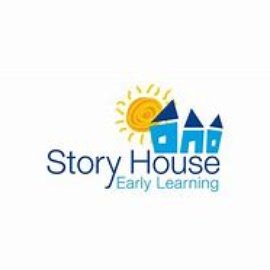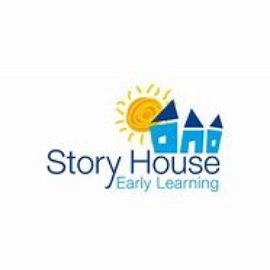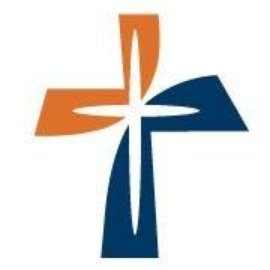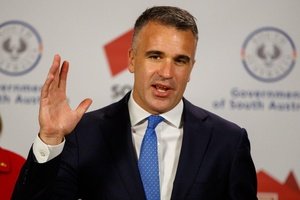A powerful advocate for Indigenous education over several decades, Pearson has long championed the teacher-directed teaching method’s proven results in assisting struggling students to catch up and succeed in school, particularly in regards to literacy and numeracy skills.
Based on the Science of Learning and Reading, Direct Instruction (DI) draws on 60 years of research and across an hour-and-a-half, Pearson provided a detailed insight into its origins, methodology and DI’s positive impact, particularly on the many disadvantaged Cape York students who have benefited from the method.
Learning how to close the gap
In his introduction, Pearson, speaking from the Cairns headquarters of GGSA, said education and advancing the opportunities and life chances of young children has probably been his most passionate driving force.
“I’ve been all too conscious throughout my life that [even though I’m] from a very poor family ... through the education my parents encouraged me in, huge life opportunities opened up for me.
“And I’m just so passionate about young people from my community having the same opportunities that I’ve had.”
Pearson said that largely due to DI, which GGSA has been implementing for 15 years now, its boarding school program has produced 500 graduates to date.
He said his team “have learned how to close the gap”.
“They’ve closed the gap on Year 12 retention and by so doing they’ve increased their job and further education opportunities – and therefore, our data tells us, they’ve closed the income gap.
“So this is hugely exciting to us, that we have this proof that by prioritising education we can close the gap – and the key to closing all of the gaps facing our people is to close the Year 12 retention gap – and then get these young people into jobs earning better income than their parents and grandparents ever did.”
The process however, must start in primary school, Pearson said.
“The achievement gap between the children who leave our remote schools is up to five to six years behind the mainstream, so when our children turn up in Cairns, or Brisbane, or Townsville, they find themselves with peers who are many years ahead of them, and this, of course, drives loneliness, disappointment, and children dropping out, because we didn’t furnish them with the education they needed to succeed.”
Pearson passionately advocated that DI is the solution to equip children, particularly from disadvantage, with the education necessary to thrive, thereby closing the educational gap and fostering equality.
Ensuring no learner is left behind
After outlining a little about the visionary behind DI, American Siegfried Engelmann (who passed away in 2019), Pearson unpacked the insights Engelmann and his colleagues gained while empirically investigating the question: ‘How many exposures were needed before children converted short-term memory to long-term memory?’ This inquiry laid the groundwork for their pioneering work.
The initial DI programs, Pearson explained, evolved to enhance the clarity and sequencing of teaching methods and were designed to ensure that no learner is left behind.
In terms of literacy, typically a classroom cohort is comprised of a “25 50 25” breakdown.
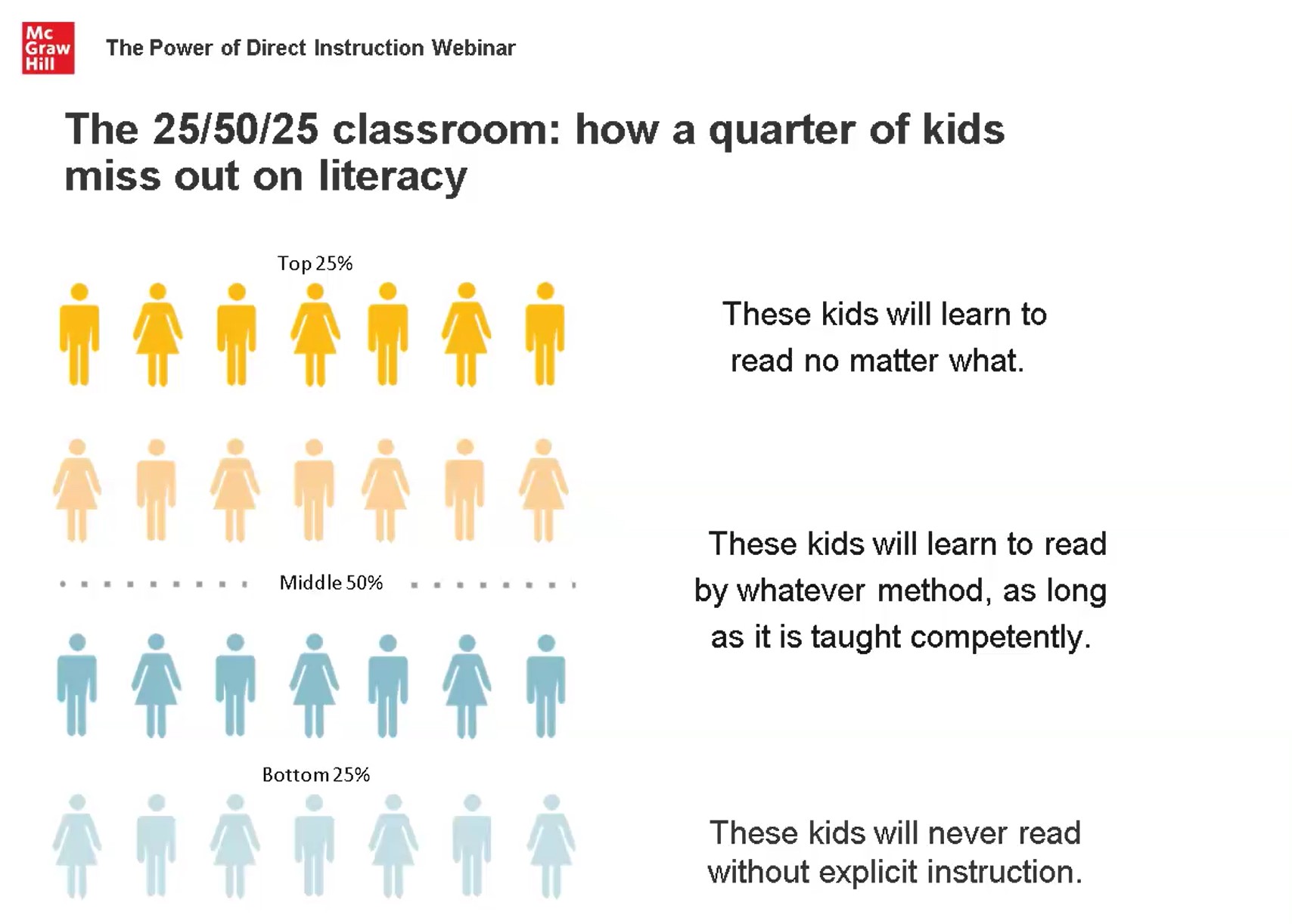
“This bottom 25 [per cent of students] is made up of children from homes without books, illiterate parents, low socioeconomic circumstances, learning difficulties,” Pearson said.
All of them, he explained, are susceptible to being part of the bottom cohort, and the crucial thing for them is for them to receive explicit and direct instruction in literacy.
“For me, the 25/50/25 classroom is the most crucial driving policy insight; this is the insight that drives all of my convictions – because I’m concerned about the bottom 25.
“They’re kids I’m worried about. I’m worried about all of the kids, but I want to put an end to the bottom 25 missing out all the time, and us, putting it down to them, when they can’t read and when they end up not finishing Year 12", Pearson said.
That said, he noted DI is aimed at all learners, and by grouping children according to their progress in ‘ability groupings’ (not ‘innate ability’, but where they sit on the current achievement spectrum), Pearson said it means the higher performing 25 per cent can "move ahead at their pace … they can move ahead in the DI program, however, the program never neglects the bottom quartile.
“The program does this by aiming instruction at every learner’s ‘zone of proximal development’.”
Pearson then transitioned to an overview of ‘Project Follow Through’, the most extensive educational experiment ever conducted.
This initiative sought to address the question of how primary education in the United States could be reformed to ensure equal opportunities in the post-civil rights era.
Pearson lamented the missed opportunity, noting that despite DI being identified as the most effective method for teaching reading and writing, the failure to implement these findings was a grave injustice.
This neglect, he argued, has perpetuated the unfulfilled promise of citizenship for African Americans and the continued deprivation of quality education for their children.
By exploring the roots of DI, the foundational research, and the critical societal implications, Pearson painted a comprehensive picture of the origins and enduring significance of the teaching method, compelling the audience to consider its potential to redress educational inequities in their own settings.
High-level points about Direct Instruction
At this point in the presentation, Pearson delved in to the 12 points that make Direct Instruction “simply good teaching”.
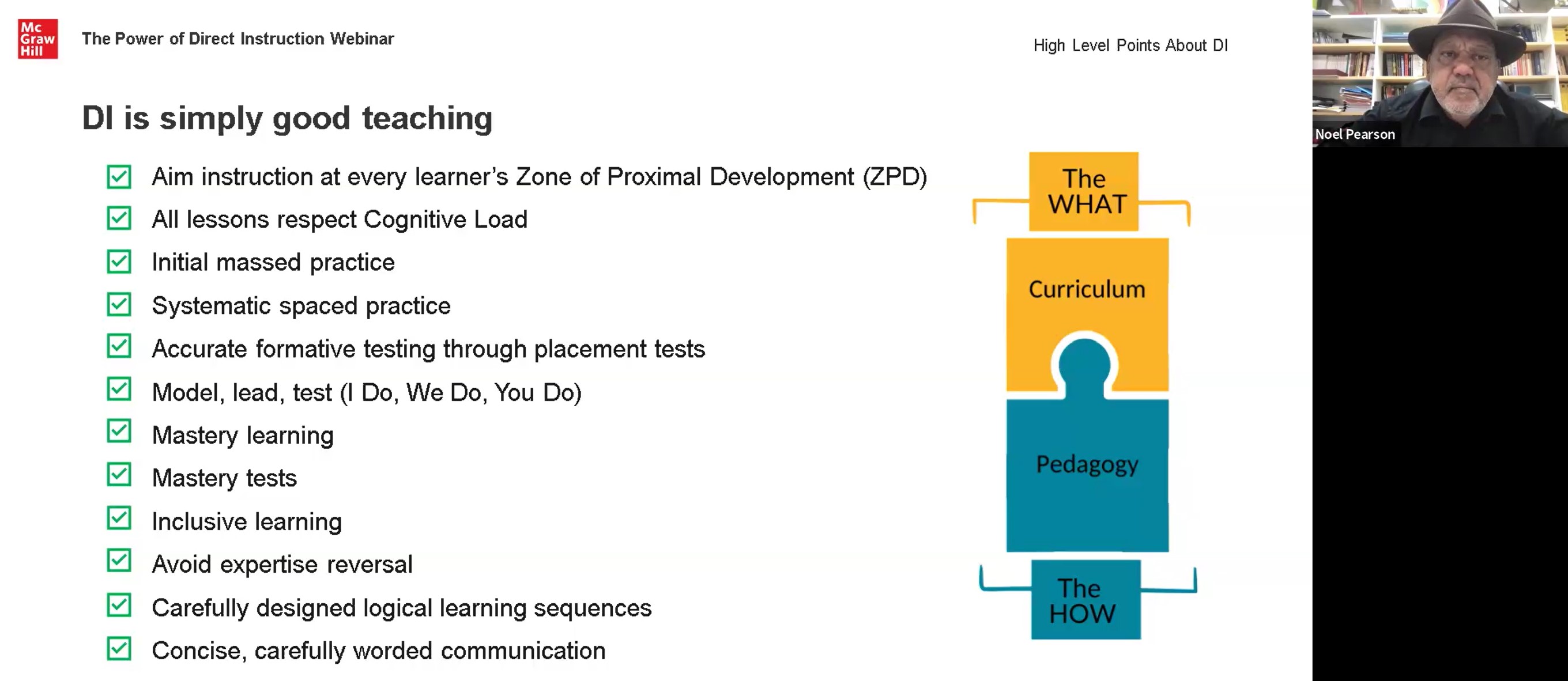
Here Pearson made note that given the growth in enthusiasm for explicit instruction, it’s important that it is understood that it's central pedagogical paradigm – I Do, We Do, You Do – is a derivative of Direct Instruction.
Pearson explained that Anita Archer, a leading proponent of explicit instruction, had a strong association with the DI community when GGSA engaged her for teacher professional development back in 2012.
“There’s some lack of recognition by people who are enthusiastic about explicit instruction, that that paradigm was actually hammered out by the DI people in the 1960s.
“It was called modelling (by the teacher) and then leading (the teacher leading the group), and then testing (testing you as a learner and independent practice),” Pearson said.
At this point, Pearson explored how DI includes both massed practice and deliberately scheduled spaced practice to combat the curve of forgetting, all while incrementally building knowledge and skills towards big conceptual ideas.
“The design of the program is not just about the next increment, it’s not just the next step, the next task.
“The program is designed to get you toward the big vista, the big concept, the big ideas...
“The program is very deliberately constructed so that concepts, the big ideas underpinning the concepts, the big picture, the gestalt, come together.”

After discussing how Direct Instruction agrees with two highly influential concepts in educational psychology: the Zone of Proximal Development (ZPD) and Cognitive Load Theory, underscoring its depth and adaptability, Pearson began a discussion on maintaining high expectations for students, illustrated by a picture bearing the words ‘If the student has not learned, the teacher has not taught’ etched in stone.
“Reflecting this principle that all students can learn, this is Zig’s (Engelmann’s) operating principle, this is the operating principle of Direct Instruction,” he explained.
“There are no alibis here, guys. If the student has not learned, the teacher has not taught. We do not blame the learner; we do not blame the child", he said.
“We have high expectations of the child, but if we hold these expectations, we must provide the necessary teaching to help them meet those standards."
High expectations, Pearson explained, cannot be just a mantra or a geeing up of the troops; it can’t just be some kind of empty form of encouragement.
“High expectations mean we have a responsibility to give the children the means to meet those expectations.
“And how do we do that? This aphorism tells us: ‘if the student doesn’t learn, then we have not taught’.”
Introducing Direct Instruction in Cape York
Here, Pearson presented a case study of Layne, who, starting as a Prep student at the Cape York Aboriginal Australian Academy, has progressed to being a boarder at a private school in Charters Towers.
Pearson then recounted the inception of the DI initiative by GGSA.
Engaging in the mid-2000s reading wars debate, he and the GGSA team were influenced by the National Reading Panel’s reports from 2005 and 2009.
Their advocacy for educational reform in Cape York culminated in the publication of a report The Most Important Reform, calling for radical change.
In 2009, Pearson and the GGSA team visited numerous charter and DI schools across North America, particularly those in African American communities. They had the opportunity to meet Engelmann and his team at the National Institute for Direct Instruction in Eugene, Oregon.
This visit, Pearson acknowledged, solidified the team’s resolve to implement DI in Cape York.
The Cape York Aboriginal Australian Academy was established at the start of 2010, comprising two schools, one in Coen (which has an enrolment of 50 students) and another in Aurukun (240 students), and currently operates in Coen and Hope Vale (110 students).
The Academy offers a comprehensive curriculum known as the 6C program, encompassing Class, Club, Culture, Childhood, Civics and Community.
The Class program is based on Direct Instruction for English and maths, and explicit instruction for subjects lacking a DI program, such as science, music and ancestral language.
Pearson emphasises that the Academy offers “a full curriculum, but DI is the backbone of our curriculum.”
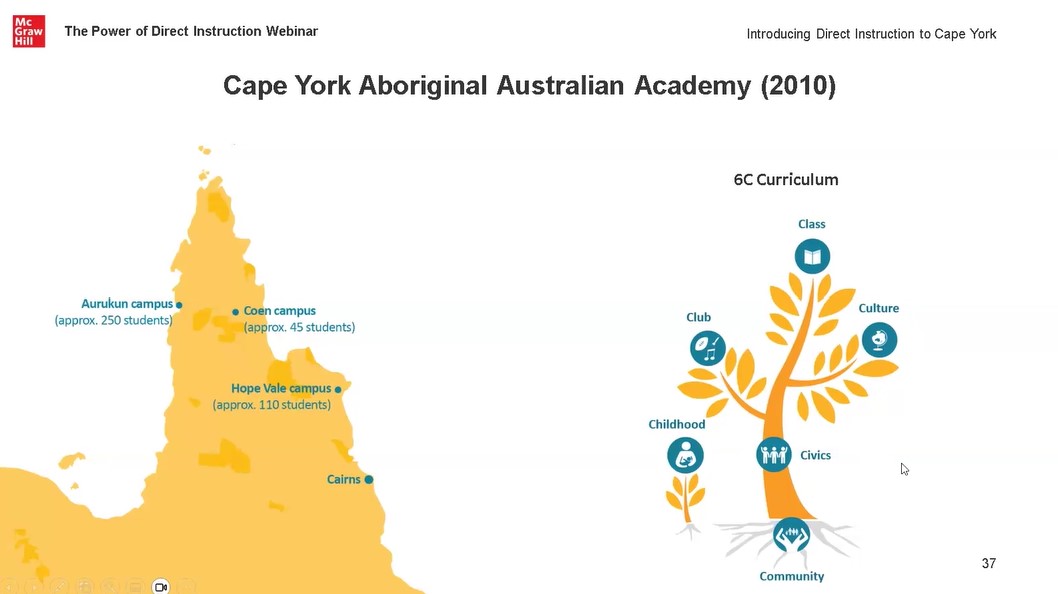
A staggering transformation
Pearson vividly recounted the astonishing transformation he witnessed at Aurukun school, describing it as one of the most extraordinary things he has seen in his life.
“It was a hell of a ride,” he said.
“We had not much more than a month by the time we got permission from the Queensland Education Department to start at the beginning of 2010. It was a very chaotic beginning, and it was one of the most extraordinary things I’ve ever witnessed – the sheer chaos and difficulty."
The schools, he continued, were in a very bad shape.
“The children were not used to much more than having a DVD put on the television set as a child-minding strategy, in between walking on the roof of the school and walking out of the classrooms at their own behest.
“We had 60 kids at one time in the time-out room … [however] the Direct Instruction program brought a logic; gave the school a logic."
All of a sudden, he explained, everybody knew what to do, “it was like a machine had started to crank up and the logic of learning had started”.
“That’s the thing about effective teaching, that’s the thing about DI – you learn something in the next lesson – not next week, not next month, not after a while – you learn in the next lesson.
“You experience that little tinge of success and excitement, because the learning has been pitched right in front of your nose and you’ve succeeded, and that excitement transfers to the teacher, because not only has the learner experienced learning success, the teacher is feeling teaching success.”
This creates, Pearson said, a virtuous wheel starting to spin between the teacher and the student.
“You succeeded with that last lesson, and guess what? We’re moving on to the next one and you’re gonna succeed with this as well.
“You’re not gonna feel like a failure,” he said.
And this virtuous wheel starts to turn in every classroom, he continued.
“But the core of it is between the teacher and each of the students, and then the classroom starts to hum – and then all the classrooms started to hum, and by Easter, we had a coherent school.
“The time-out room went from 60 down to four or five.
“And five o’clock on a Friday afternoon the kids were still doing their lessons, it was just one of the most extraordinary things I’ve seen – a poor school, completely dysfunctional, completely chaotic, completely without purpose, without logic, and yet when you get the instruction right, the school comes right," he concluded.
A nationwide opportunity
The rest of the webinar unpacked more specifically the instructional design, or the hidden architecture, of DI, and how GGSA is supporting schools around the nation to implement Direct Instruction effectively.
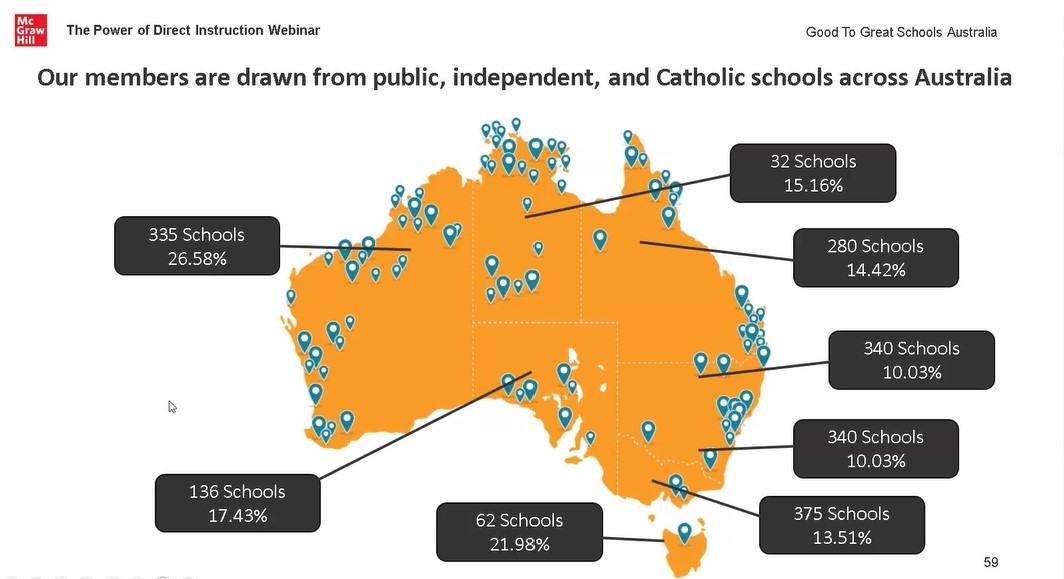
Pearson described how GGSA maps DI programs to the Australian Curriculum and develops resources to enable schools to deliver DI in complete alignment with it.
“We have professional learning resources for teachers online,” he said.
“These are freely available, on how to deliver and implement Direct Instruction. And teachers can access professional learning resources on our website. And all of our resources are free to schools.”
He then described GGSA’s ongoing commitment to enhancing educational outcomes, by providing comprehensive implementation, support, and coaching services for schools nationwide to facilitate the adoption of explicit and direct instruction programs.
“And we’ve been doing that for 15 years. We have sites all over the country,” he said.
Pearson’s secret to closing the gap
In closing, Pearson revealed his secret to closing the achievement gap, whether that be for migrant kids, poor white kids, or Indigenous kids.
“If I’ve learned anything that I’m absolutely convicted about is that you close the gap in the beginning," he declared.
“You close the gap so that by the time they start, they’re at the starting line; they’re lining up for the 800-metre race.
“You don’t want to start 800 metres behind [the starting line], or 50 metres behind everybody else, or 200 metres behind.
“You want them at the line. Well, this is the way to get them at the line. You close the achievement gap through 20 minutes a day in pre-primary school pre-literacy education.”
The two programs are (mastery of the first 30 lessons of) ‘Language for Learning’, an SRA program, an early generation DI program, and (mastery up to lesson 40 of) ‘Reading Mastery - Language’.
“It’s 20 minutes a day for kids in Kindergarten. If you do this 20 minutes a day, they will turn up in Prep fully at the starting line,” Pearson said.
“And at the starting line, they’ll actually be ahead of kids in mainstream schools, they could be more prepared than the average kid at a mainstream school.
“If you can get kids in Kindergarten to do 20 minutes a day, they can do the play program for all of the other minutes of the day. These 20 minutes are the most crucial," he explained.
Pearson said, as a nation, we’ve seen too many instances of miracles with young learners all of a sudden, from non-English speaking backgrounds, no books in the home, parents who can’t read and write, living in poverty.
“I’ve seen these kids. When they’re given this power here, all of a sudden you’ve got the means for them to start. No gap opens up.
“The best gap is the gap that never starts. We don’t have to solve every socio-economic problem in the world. If we solve this, we give the child the ability,” he concluded.




